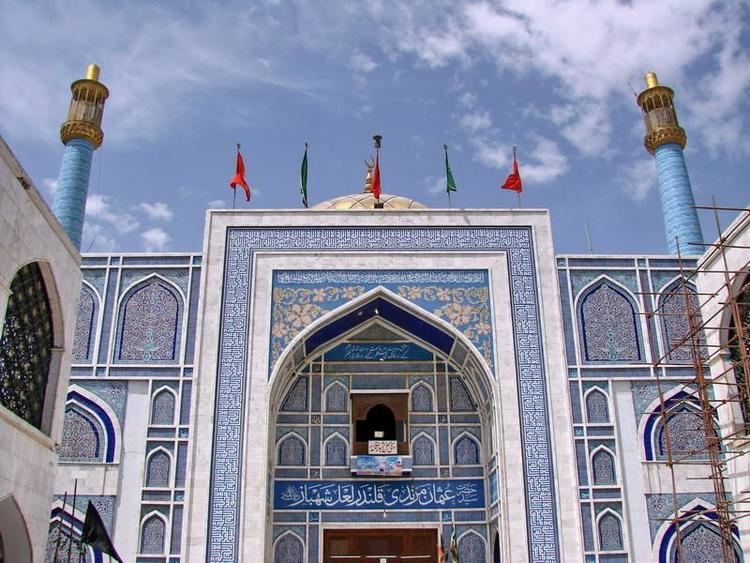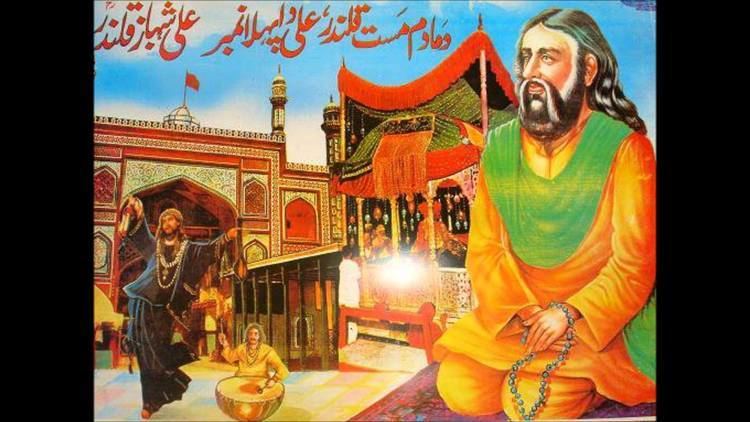Other names Lal Shahbaz Qalandar Role Poet Title Shahbaz Parents Syed Ibrahim Kabiruddin | Predecessor Baha-ud-din Zakariya Name Lal Qalandar Based in Sehwan Sharif, Najaf | |
 | ||
Religion Islam, specifically the Suhrawardiyya Sufi order Successor Syed Muhammad Raza Shah Subzwari Died 1274, Sehwan Sharif, Pakistan | ||
Period in office 12th/13th century Similar Bu Ali Shah Qalandar, Shah Abdul Latif Bhittai, Sachal Sarmast | ||
37 story of hazrat lal shahbaz qalandar karachi pakistan
Usman Marwandi (1177–19 February 1275), popularly known as Lal Shahbaz Qalandar (Sindhi: لعل شھباز قلندر), was a Sufi philosopher-poet of present-day Afghanistan and Pakistan. He was called Lal ("ruby-colored") after his usual red attire and Shahbaz to denote a noble and divine spirit and Qalandar as he was a wandering holy man.
Contents
- 37 story of hazrat lal shahbaz qalandar karachi pakistan
- Fazail of Lal Shahbaz Qalandar asws Allama Asif Raza Alvi 25th October 2016 London UK
- Life
- Shrine
- Mela Urs Annual Fair
- The 2017 terrorist attack
- In poetry and prose
- References

Fazail of Lal Shahbaz Qalandar (asws) | Allama Asif Raza Alvi | 25th October 2016 | London, UK
Life

Lal Shahbaz Qalandar, son of Ibrahim Kabeeruddin, was born in Marwand. His ancestors had migrated from Baghdad and settled in Mashhad, before moving again to Marwand. He lived when the Ghaznavid and Ghurids ruled in the Indus region. A contemporary of Rumi, he travelled around the Muslim world and settled in Sehwan where he was eventually buried. There is evidence of his presence in Sindh in 1196 when he met Pir Haji Ismail Panhwar of Paat and he is believed to have arrived in Sehwan around 1251. There he established a meeting house (khanqah), taught in the Fuqhai Islam Madarrsah and wrote his treatises Mizan-us-Surf, Kism-e-Doyum, Aqd and Zubdah. Lal Shahbaz lived a celibate life and died in the year 1300 at the age of 151. In Multan he met Baha-ud-din Zakariya of the Suhrwardiyya, Baba Fariduddin Ganjshakar of the Chishtiyya and Syed Jalaluddin Bukhari. The friendship of these four became legendary, they were known as the Chahar Yar (In Persian "the four friends"). According to some historians the four visited various parts of Sindh, Punjab (in present-day Pakistan) and southern part of India.. Shahbaz became a profound scholar of religions, fluent in many languages including Pashto, Persian, Turkish, Arabic, Sindhi and Sanskrit.

Following his death, Hindus within Sindh began to identify Lal Shahbaz Qalandar as an incarnation of their patron deity, Jhulelal. This connection was emphasized by the popular spiritual song Dama Dam Mast Qalandar which referred to him by the name Jhulelal. Over time, the Jhulelal has become a nickname for him, among both Hindu and Muslim Sindhis.
Shrine

The shrine of Lal Shahbaz Qalandar was built in 1356 and decorated with Sindhi 'kashi-tiles', mirror-work and a gold-plated door donated by the Shah of Iran, Reza Shah Pahlavi and installed by the late Prime Minister of Pakistan, Zulfikar Ali Bhutto. The inner sanctum is about 100 square yards with a silver-canopied grave in the middle, according to Nadeem Wagan, Cutharo silver donated by Sardar Mahboob Ali Khan Wagan (Chief Sardar of Wagan Tribe) on one side of the marble floor is a row of about 12-inch-high (300 mm) folding wooden stands, on which there is a set copies of Quran for devotees to read. On the other side, beside a bundle of incense, are rows of oil-lamps lighted by devotees. Thousands of devotees visit the tomb particularly every Thursday.
Mela / Urs (Annual Fair)

Lal Shahbaz's annual Urs (death anniversary celebration), held on the 18 Sha'aban – the eighth month of the Muslim lunar calendar, brings more than half a million pilgrims from all over Pakistan. On each morning of the three-day feast the narrow lanes of Sehwan are packed with pilgrims, fakirs and devotees making their way to the shrine to commune with the saint, offer tributes and ask for their wishes. (Sao Sumar) singing from 6am till 8am the next day. They invite bands of folk-singers (mandali) from different regions each year.
The 2017 terrorist attack

On 16 February 2017, the Islamic State's Khorasan faction claimed responsibility for a suicide attack on the shrine which resulted in the deaths of 88 people. The following morning, the shrine's caretaker continued the daily tradition of ringing the shrine's bell at 3:30 A.M. and defiantly vowed that he would not be intimidated by terrorists. The shrine's dhamaal, or meditative dancing ceremony, was resumed the very next evening following the attack.
In poetry and prose
A qawwali sung by many Pakistani, Bangladeshi and Indian singers and musicians like Noor Jehan, Ustad Nusrat Fateh Ali Khan, Abida Parveen, Sabri Brothers, Runa Laila, Wadali brothers, Shankar-Ehsaan-Loy, Reshman and Mika Singh, "Lal Meri Pat Rakhiyo ustad Fareed Ayaz and Abu Mohammad..."(See Dama Dam Mast Qalandar). This poem was initially written by Amir Khusrow, then further modified by Baba Bulleh shah. Lal Shabaz Qalandar has also been referred to as "Jhulelal".
